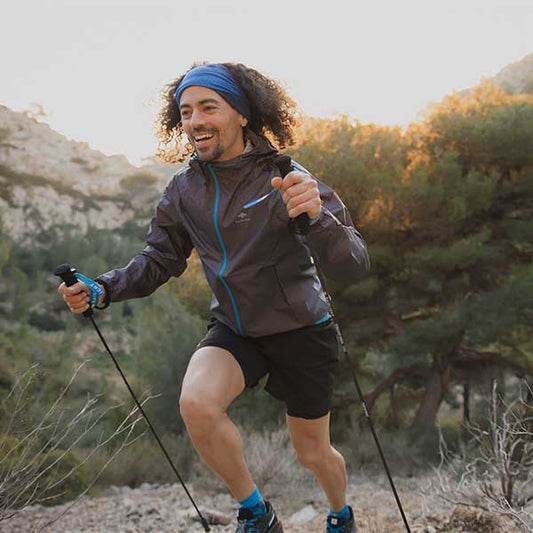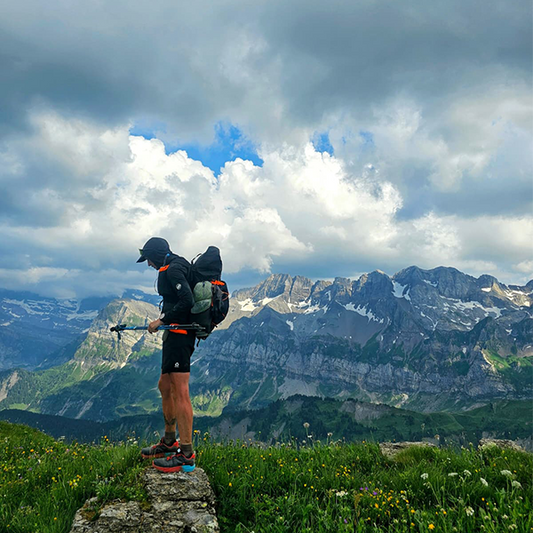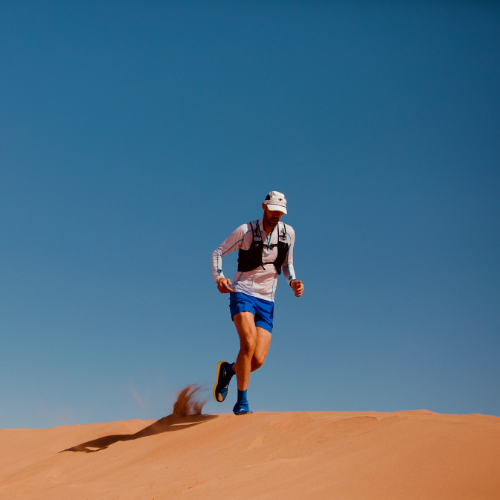Desert races such as the Marathon des Sables®, the Raidlight Desert Trophy® or the Oman Desert Marathon® are often considered the ultimate running challenges, attracting runners from all over the world. This type of event requires meticulous organization and specific equipment.
In this guide, we'll look at the particularities of desert racing, examine in detail how to best prepare and organize your trail pack, and then deliver all our tips and advice.
Let's take a look at the specifics of a desert stage race.
Extreme weather conditions : The desert offers extreme climatic conditions, with temperatures reaching over 50°C during the day and dropping considerably at night. This intense heat can lead to heatstroke, dehydration and other medical problems.
Varied terrain : Desert terrain varies between sand dunes, pebbles, rocks, dry riverbeds and barren plains. Runners need to be prepared for these different types of terrain.
Self-sufficiency : Many desert races are self-sufficient, meaning that runners have to carry all their own equipment, food and water for the duration of the race, with the exception of the water provided at refreshment points. This adds considerably to the weight of the backpack and the difficulty of the race.
Complex logistics : Taking part in a desert race requires complex planning and logistics, particularly when it comes to preparing equipment and managing resources during the race.
It's for all these reasons that it's important to anticipate and be meticulous in preparing your pack. This step is crucial to ensuring a successful experience in this extreme event.
We won't go into detail about the equipment you'll be wearing (shoes, shorts, top, desert gaiters, sahara cape etc.), as we've dedicated a full article to this subject. You can find it by clicking here

How to prepare and organize your pack efficiently?
Checklist : draw up a comprehensive list of everything you plan to take with you, including clothing, bivouac gear, food, hydration, toiletries and mandatory equipment.
Choosing the right trail pack : opt for a hydration pack specially designed for stage races. Make sure it's lightweight, comfortable and has multiple pockets for optimal organization. When you're packing your gear into your pack, optimizing it shouldn't be at the expense of your comfort.
Keep your pack organization simple and pragmatic. As we all know, effort and fatigue test our patience, so to avoid wasting time and energy searching for your belongings, plan a separate pocket for each container:
- For the food
- For the clothes
- For safety equipment and medicines
- For toiletries
That way, everything will be clear and structured.
Once you've prepared your pack, try it out on several training outings to make sure it fits properly and that you're comfortable with the weight and distribution of the equipment.
Clothing : Choose lightweight, breathable, quick-drying clothing to minimize weight and maximize comfort.Make sure your clothing is adapted to the extreme temperatures of the desert, including layers for the cold of the night and light clothes for the heat of the day.
Nutrition and hydration : Most race organizations require a minimum of 2000 Kcal/day. Choose energy foods that are light, easy to carry, digestible and heat-resistant. You'll also need to supplement your mineral intake, so pack salt and/or electrolyte tablets. Make sure you have a variety of options to meet your nutritional needs during the race.
To optimize space in your pack, we recommend emptying freeze-dried food sachets and transferring them to freezer bags, labelled with the name of the meal and calories. Lighter, more compact and a real space-saver.
During this type of adventure, the mental load can be very energy-consuming, so knowing what you're going to eat by planning your menus in advance on your laptop will take a load off your mind. There are no questions to ask, no mistakes about calorie counts, and no risk of eating too much or too little.
For example: Day 1 - Morning Muesli 447 calories / Noon Coucous 398 calories / Evening Beef Bourguignon 1000 calories.
A final word of advice on nutrition: you'll never regret having too much to eat, but too few calories could jeopardize your race.
Here is a non-exhaustive list of the equipment needed for a desert race:
Compulsory equipment
- A running pack
- A sleeping bag (opt for an ultra-light, compact sleeping bag suitable for desert night-time temperatures)
- a headlamp + 1 full set of spare batteries,
- 10 safety pins
- a compass with 1° or 2° accuracy
- a lighter
- a whistle
- a metal-bladed knife
- a skin antiseptic
- an aspivenin pump
- a signal mirror
- a survival blanket
- a tube of sunscreen
- 200 euros or dirham equivalent
- a passport
- an original medical certificate supplied by AOI, duly completed and signed by the doctor
- Original ECG and resting tracing
Power supply and accessories
- Food, supplies, salt tablets...
- Spoon/fork
- Bowl/plate
- Stove
Clothing and equipment
- Poles
- Change of clothes (socks, swimsuit, shorts, underwear)
- Sunglasses
- Saharienne
- Bib holder
- Front pack
Toiletries and first-aid kit
- Dressings & medication (make up a complete first-aid kit including dressings, pain and inflammation medication, antiseptics, allergy medication and any other personal medication you may need).
- Little piece of soap
- Dry wipes
- Toothpaste
- Toothbrush
- Quick-drying towel
- Hairbrushes, elastics
Bivouac
- Mattresses
- Earplugs
- Seamless top
- Tyvek top and bottoms
- Sleep eyemask
- Recycled flip-flops
- External battery for recharging your phone, watch and headset
Before you leave by plane, don't hesitate to slip a pair of running clothes into your carry-on bag, or even use your running pack as a carry-on bag. It's best to anticipate any potential malfunction on the part of the airline.
Properly equipping yourself for a desert stage race is essential to maximize your chances of success in this demanding event. By carefully selecting your clothing, running gear, nutrition and safety equipment, you'll be well prepared for the unique challenges of the desert. With the right organization and physical preparation, this race is sure to be an unforgettable experience.










